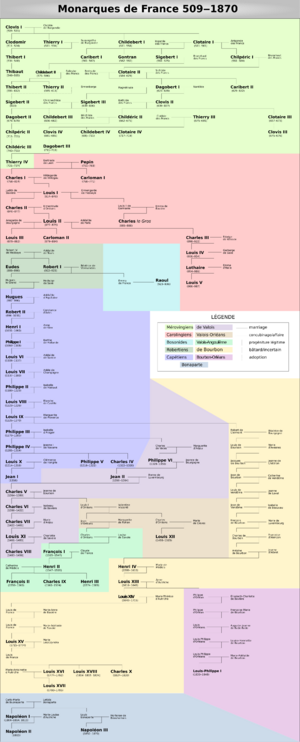List of French monarchs facts for kids
France was led by monarchs from 843 until 1870. This period saw a few breaks in royal rule.
Some historians used to think that Clovis I, a Frankish king (who ruled from 507 to 511), was the first king of France. However, most historians today agree that the Kingdom of France really began in 843. This was when the Carolingian Empire broke apart, forming West Francia, which later became modern France.
Contents
Royal Titles: How Kings Were Called
For a long time, French kings were called "King of the Franks" (Rex Francorum). This changed around the late 1100s. Philip II, who ruled from 1180 to 1223, was the first to use the title "King of France" (Rex Franciae). After him, the older title slowly faded away. But sometimes, kings like Louis XII and Francis I still used "King of the Franks" on coins until the 1700s.
During certain times, like 1791–1792 and after 1830, kings were called "King of the French" (roi des Français). This was a new idea. It meant the king's title was linked to the French people, not just to owning the land of France.
When the House of Bonaparte ruled, the title changed to "Emperor of the French" (Empereur des Français). This happened during the First (1804–1814, and 1815) and Second (1852–1870) French Empires.
From the 1300s until 1801, English (and later British) monarchs claimed to be kings of France. This claim was mostly just on paper. The only time it was real was during a short part of the Hundred Years' War. Then, Henry VI of England controlled much of northern France, including Paris. By 1453, the English were mostly pushed out of France. French historians do not usually count Henry VI as a true king of France.
Frankish Kings: Early Rulers of West Francia
The Carolingian Dynasty (843–887)
The Carolingians were a powerful Frankish family. They became very strong in the 700s. They eventually took over from the earlier Merovingian kings. The family is named after Charles Martel. His son, Pepin the Short, became King of the Franks in 751.
Under Charles the Great (who ruled from 768 to 814), the Frankish kingdom grew huge. It stretched into Central Europe, including Italy and most of modern Germany. The Pope even crowned Charlemagne "Emperor of the Romans." This title later went to German rulers.
Charlemagne's son, Louis the Pious (who ruled from 814 to 840), divided the kingdom among his sons. After Louis died, there was a civil war. It ended with the Treaty of Verdun in 843. This treaty split Francia into three kingdoms. Modern France grew from West Francia. The eastern part became the Holy Roman Empire and later Germany. By this time, the two parts had already developed different languages and cultures.
| Portrait | Name | Reign | How They Became King | Key Facts |
|---|---|---|---|---|
 |
Charles II "the Bald" | 843 – 877 | Son of Louis the Pious; recognized as king after the Treaty of Verdun. | Born 823, died 877 (aged 54). He was also King of Aquitaine and crowned Emperor in 875. |
 |
Louis II "the Stammerer" | 877 – 879 | Son of Charles the Bald. | Born 846, died 879 (aged 32). He was also King of Aquitaine. |
 |
Louis III | 879 – 882 | Son of Louis the Stammerer. | Born 863, died 882 (aged 19). He ruled the northern part of the kingdom. |
 |
Carloman II | 879 – 884 | Son of Louis the Stammerer. | Born 866, died 884 (aged 18). He ruled the southern part of the kingdom. |
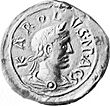 |
Charles (III) "the Fat" | 884 – 887 | Grandson of Louis the Pious. | Born 839, died 888 (aged 48–49). He was King of East Francia and Emperor. He was the last ruler to control all Frankish lands. |
The Robertian Dynasty (888–898)
| Portrait | Name | Reign | How They Became King | Key Facts |
|---|---|---|---|---|
 |
Odo | 888 – 898 | Elected king by French nobles. Son of Robert the Strong. | Born around 858, died 898 (aged approx. 40). He bravely defended Paris from Vikings. |
The Carolingian Dynasty Returns (898–922)
| Portrait | Name | Reign | How They Became King | Key Facts |
|---|---|---|---|---|
 |
Charles III "the Simple" | 898 – 922 | Son of Louis the Stammerer. | Born 879, died 929 (aged 50). He was captured by his enemies and died in prison. |
The Robertian Dynasty Again (922–923)
| Portrait | Name | Reign | How They Became King | Key Facts |
|---|---|---|---|---|
 |
Robert I | 922 – 923 | Son of Robert the Strong and Odo's younger brother. | Born 865, died 923 (aged 58). He was the only French king to die in battle. |
The Bosonid Dynasty (923–936)
| Portrait | Name | Reign | How They Became King | Key Facts |
|---|---|---|---|---|
 |
Rudolph | 923 – 936 | Son-in-law of Robert I. | Died 936. His rule was filled with civil wars and Viking raids. |
The Carolingian Dynasty's Final Rule (936–987)
| Portrait | Name | Reign | How They Became King | Key Facts |
|---|---|---|---|---|
 |
Louis IV "from Overseas" | 936 – 954 | Son of Charles the Simple; returned from exile in England. | Born 921, died 954 (aged 33). He died after falling off his horse. |
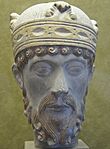 |
Lothair | 954 – 986 | Son of Louis IV. | Born 941, died 986 (aged 44). |
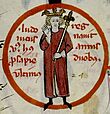 |
Louis V "the Do-Nothing" | 986 – 987 | Son of Lothair. | Born 967, died 987 (aged 20). He died in a hunting accident. |
The Capetian Dynasty (987–1792)
The Capetian dynasty began with Hugh Capet. He was a powerful duke elected king in 987. Almost every French monarch after him was a male descendant of Hugh Capet. The crown passed from father to son for a long time. This period is called the Direct Capetian rule.
Later, the crown went to the House of Valois. This was a branch of the Capetian family. The Valois' claim was challenged by Edward III of England. He was the English king and claimed the French throne through his French mother. This led to the Hundred Years' War.
The Valois line ended in the late 1500s during the French Wars of Religion. The House of Bourbon then took over. They were also related to the Capetians through Louis IX. The Bourbons ruled until the French Revolution. They were later restored after Napoleon's fall. The last Capetian ruler was Louis Philippe I, who ruled during the July Monarchy (1830–1848).
The House of Capet (987–1328)
These kings are also known as the "Direct Capetians."
| Portrait | Name | Arms | Reign | How They Became King | Key Facts |
|---|---|---|---|---|---|
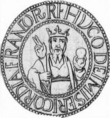 |
Hugh "Capet" | 987 – 996 | Elected king by French nobles. Grandson of Robert I. | Born around 940, died 996 (aged approx. 55). He was Duke of the Franks before becoming king. | |
 |
Robert II "the Pious" | 996 – 1031 | Only son of Hugh Capet. | Born around 970, died 1031 (aged approx. 60). He was excommunicated by the Church for his marriages. | |
| Hughes (junior king) |
1017 – 1025 (under Robert II) |
Son of Robert II. | Born around 1007, died 1025 (aged approx. 18). | ||
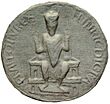 |
Henry I | 1031 – 1060 | Son of Robert II. | Born around 1005, died 1060 (aged approx. 55). His reign had many struggles with powerful lords. | |
 |
Philip I "the Amorous" | 1060 – 1108 | Son of Henry I. | Born 1052, died 1108 (aged 56). He ruled under his mother's guidance until 1066. | |
 |
Louis VI "the Fat" | 1108 – 1137 | Son of Philip I. | Born 1081, died 1137 (aged 56). He helped make the king's power stronger. | |
| Philippe (junior king) |
1129 – 1131 (under Louis VI) |
Son of Louis VI. | Born 1116, died 1131 (aged 15). | ||
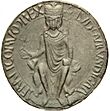 |
Louis VII "the Young" | 1137 – 1180 | Son of Louis VI. | Born 1120, died 1180 (aged 60). He was known for his conflicts with the English king. | |
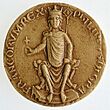 |
Philip II "Augustus" |  |
1180 – 1223 | Son of Louis VII. | Born 1165, died 1223 (aged 57). He is seen as one of France's greatest rulers. He was the first to call himself "King of France." |
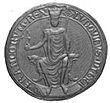 |
Louis VIII "the Lion" | 1223 – 1226 | Son of Philip II. | Born 1187, died 1226 (aged 39). He tried to invade England. | |
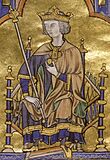 |
Louis IX "the Saint" | 1226 – 1270 | Son of Louis VIII. | Born 1214, died 1270 (aged 56). He ruled under his mother's guidance for a while. He died during a Crusade. He is the only French king honored as a saint by the Catholic Church. | |
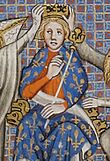 |
Philip III "the Bold" | 1270 – 1285 | Son of Louis IX. | Born 1245, died 1285 (aged 40). He expanded France's influence in Europe. | |
 |
Philip IV "the Fair" |  |
1285 – 1314 | Son of Philip III. | Born 1268, died 1314 (aged 46). He was also King of Navarre. He strengthened royal power and had conflicts with the Pope. |
 |
Louis X "the Quarreller" | 1314 – 1316 | Son of Philip IV. | Born 1289, died 1316 (aged 26). He was also King of Navarre. His short reign had many conflicts with nobles. | |
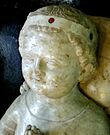 |
John I "the Posthumous" | 1316 (4 days) | Son of Louis X. | He was king for only four days. He is the youngest and shortest-reigning monarch in French history. | |
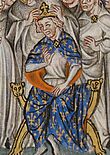 |
Philip V "the Tall" | 1316 – 1322 | Son of Philip IV and uncle of John I. | Born 1293/4, died 1322 (aged 28–29). He was also King of Navarre. He died without a male heir. | |
 |
Charles IV "the Fair" | 1322 – 1328 | Son of Philip IV and younger brother of Philip V. | Born 1294, died 1328 (aged 34). He was also King of Navarre. He died without a male heir, ending the direct Capetian line. |
The House of Valois (1328–1589)
When Charles IV died, it started the Hundred Years' War. This war was between the House of Valois and the English House of Plantagenet. Both families claimed the French throne. The Valois family said they had the right to rule because of an old law called Salic law. This law meant only male heirs could inherit the throne. The Valois were male descendants of Philip III.
The Plantagenets, however, argued they were closer to a more recent French king. Edward III of England was the grandson of Philip IV through his mother. The two families fought the Hundred Years' War over this. The Valois eventually won. French history books count their leaders as the rightful kings.
One English king, Henry VI of England, briefly controlled the French throne. This was based on a treaty. The Valois family ruled France until their line ended in 1589. This happened during the French Wars of Religion.
| Portrait | Name | Arms | Reign | How They Became King | Key Facts |
|---|---|---|---|---|---|
 |
Philip VI "the Fortunate" |  |
1328 – 1350 | Grandson of Philip III and cousin of Charles IV. | Born 1293, died 1350 (aged 57). His reign was dominated by the start of the Hundred Years' War. |
 |
John II "the Good" | 1350 – 1364 | Son of Philip VI. | Born 1319, died 1364 (aged 45). He was captured by the English in battle. | |
 |
Charles V "the Wise" |  |
1364 – 1380 | Son of John II. | Born 1337, died 1380 (aged 43). His reign saw many internal struggles. |
 |
Charles VI "the Mad" "the Beloved" |  |
1380 – 1422 | Son of Charles V. | Born 1368, died 1422 (aged 53). He suffered from mental illness for a long time. |
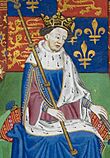 |
Henry VI of England (claimant) |
 |
1422 – 1453 (disputed) |
Maternal grandson of Charles VI. | Born 1421, died 1471 (aged 49). He was also King of England. |
 |
Charles VII "the Victorious" "the Well-Served" |  |
1422 – 1461 | Son of Charles VI. | Born 1403, died 1461 (aged 58). The Hundred Years' War ended during his rule. |
 |
Louis XI "the Prudent" "the Universal Spider" |  |
1461 – 1483 | Son of Charles VII. | Born 1423, died 1483 (aged 60). He made the king's power stronger. He was called "the Universal Spider" for his clever plans. |
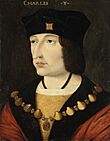 |
Charles VIII "the Affable" |  |
1483 – 1498 | Son of Louis XI. | Born 1470, died 1498 (aged 27). He started the long Italian Wars. He died after hitting his head. |
The House of Valois-Orléans (1498–1515)
| Portrait | Name | Arms | Reign | How They Became King | Key Facts |
|---|---|---|---|---|---|
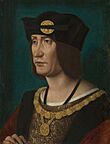 |
Louis XII "Father of the People" |  |
1498 – 1515 | Great-grandson of Charles V. | Born 1462, died 1515 (aged 52). He briefly conquered parts of Italy. |
The House of Valois-Angoulême (1515–1589)
| Portrait | Name | Arms | Reign | How They Became King | Key Facts |
|---|---|---|---|---|---|
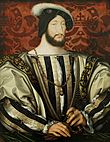 |
Francis I "the Father of Letters" |  |
1515 – 1547 | Cousin and son-in-law of Louis XII. | Born 1494, died 1547 (aged 52). He was a great supporter of arts and learning during the Renaissance. |
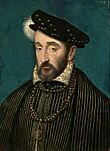 |
Henry II | 1547 – 1559 | Son of Francis I. | Born 1519, died 1559 (aged 40). He died after an accident during a jousting tournament. | |
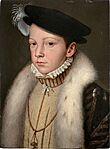 |
Francis II | 1559 – 1560 | Son of Henry II. | Born 1544, died 1560 (aged 16). He was also King Consort of Scotland. He was a weak and sick boy. | |
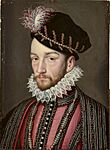 |
Charles IX | 1560 – 1574 | Younger brother of Francis II. | Born 1550, died 1574 (aged 23). The Wars of Religion began during his reign. | |
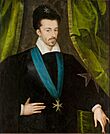 |
Henry III |  |
1574 – 1589 | Younger brother of Francis II and Charles IX. | Born 1551, died 1589 (aged 37). He ruled during the terrible Wars of Religion. He was assassinated. |
The House of Bourbon (1589–1792)
After Henry II died, his family line seemed strong. But his sons died without male heirs. This led to a crisis over who would be the next king. The best claimant was King Henry III of Navarre. However, he was a Protestant, which many French nobles did not accept.
After winning many battles, Henry became Catholic. He was then crowned King Henry IV, starting the House of Bourbon. This was the second time the thrones of Navarre and France were joined. The House of Bourbon was overthrown during the French Revolution. A short-lived republic took its place.
| Portrait | Name | Arms | Reign | How They Became King | Key Facts |
|---|---|---|---|---|---|
 |
Charles X (claimant) |
 |
1589 – 1590 (disputed) |
Descendant of Louis IX. Claimed the throne against Henry of Navarre. | Born 1523, died 1590 (aged 66). He was imprisoned during his "reign." |
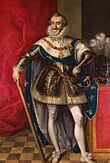 |
Henry IV "the Great" "the Good King" |  |
1589 – 1610 | Descendant of Louis IX. | Born 1553, died 1610 (aged 56). He was also King of Lower Navarre. He was killed in Paris. |
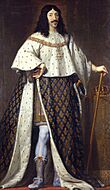 |
Louis XIII "the Just" | 1610 – 1643 | Son of Henry IV. | Born 1601, died 1643 (aged 41). He was the last King of Lower Navarre. | |
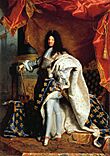 |
Louis XIV "the Great" "the Sun King" | 1643 – 1715 | Son of Louis XIII. | Born 1638, died 1715 (aged 76). He ruled under his mother's guidance until 1651. He is one of the longest-reigning monarchs in history. | |
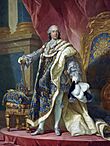 |
Louis XV "the Beloved" | 1715 – 1774 | Great-grandson of Louis XIV. | Born 1710, died 1774 (aged 64). He ruled under a regent until 1723. | |
 |
Louis XVI | 1774 – 1792 | Grandson of Louis XV. | Born 1754, died 1793 (aged 38). He was forced to accept a constitutional monarchy after 1789. He was removed from power and publicly executed. | |
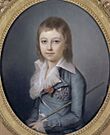 |
Louis XVII (claimant) |
1793 – 1795 (disputed) |
Son of Louis XVI. | Born 1785, died 1795 (aged 10). He was imprisoned by revolutionary forces and died in captivity. |
France in the 1800s: Revolutions and Empires
The 1800s were a very busy time in French politics. It began with the French Revolution. This revolution removed and then executed Louis XVI. Royalists still believed his son, Louis XVII, was the rightful king. But Louis XVII was held prisoner and died without ever ruling.
The republican government changed forms several times. Then, France was declared an empire. This happened when Napoleon Bonaparte became Emperor Napoleon I. Napoleon was overthrown twice after losing battles.
After Napoleon, there were two different royal governments. The Bourbon Restoration was led by Louis XVI's younger brothers. Then came the July Monarchy, led by Louis Philippe I. He was a distant cousin of the previous kings.
The French Revolution of 1848 ended the monarchy again. A short Second Republic lasted four years. Its president then declared himself Emperor Napoleon III. He was later removed from power, and the Third Republic began. This was the end of monarchic rule in France.
The House of Bonaparte: First French Empire (1804–1814)
| Portrait | Name | Arms | Reign | How They Became Emperor | Key Facts |
|---|---|---|---|---|---|
 |
Napoleon I |  |
1804 – 1814 | He was the First Consul of the French Republic. He declared himself Emperor. | Born 1769, died 1821 (aged 51). He conquered much of Europe. He is known as one of history's greatest military leaders. He was forced to give up his throne and sent away to an island. |
 |
Napoleon II (claimant) |
1814 (2 days; disputed) | Son of Napoleon I. | Born 1811, died 1832 (aged 21). He was not recognized by other countries. |
The House of Bourbon Returns (1814–1815)
| Portrait | Name | Arms | Reign | How They Became King | Key Facts |
|---|---|---|---|---|---|
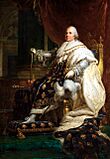 |
Louis XVIII "the Desired" |  |
1814 – 1815 (1st time) | Younger brother of Louis XVI. Other European royal families helped him get his throne back. | Born 1755, died 1824 (aged 68). He fled France when Napoleon returned. |
The House of Bonaparte: Hundred Days (1815)
| Portrait | Name | Arms | Reign | How They Became Emperor | Key Facts |
|---|---|---|---|---|---|
 |
Napoleon I |  |
1815 (94 days) | The French Army brought him back as Emperor after he escaped from an island. | Born 1769, died 1821 (aged 51). He gave up his throne after losing the Battle of Waterloo. He was sent to another island, where he died. |
 |
Napoleon II (claimant) |
1815 (15 days; disputed) | Son of Napoleon I. | Born 1811, died 1832 (aged 21). He was not recognized by other countries. |
The Bourbon Restoration Continues (1815–1830)
| Portrait | Name | Arms | Reign | How They Became King | Key Facts |
|---|---|---|---|---|---|
 |
Louis XVIII "the Desired" |  |
1815 – 1824 | Younger brother of Louis XVI; restored to the throne. | Born 1755, died 1824 (aged 68). He tried to rule as a constitutional monarch. He was the last French monarch to die while still reigning. |
 |
Charles X | 1824 – 1830 | Younger brother of Louis XVI and Louis XVIII. | Born 1757, died 1836 (aged 79). He tried to bring back old ways of ruling. He gave up his throne after the July Revolution. | |
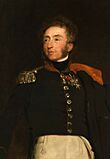 |
Louis XIX (?) (claimant) |
1830 (20 minutes; disputed) | Son of Charles X. | Born 1775, died 1844 (aged 68). He was only king for a very short time. | |
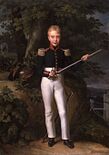 |
Henry V (claimant) |
1830 (7 days; disputed) | Grandson of Charles X. | Born 1820, died 1883 (aged 62). He later claimed the throne from exile. |
The House of Bourbon-Orléans: July Monarchy (1830–1848)
The Bourbon Restoration ended with the July Revolution in 1830. This revolution removed Charles X. He was replaced by Louis Philippe I, a distant cousin with more modern political ideas.
Charles X named Louis Philippe as a temporary ruler for his young grandson. He asked Louis Philippe to tell the French Parliament that his grandson should be the next king. But Louis Philippe did not do this. He wanted to become king himself. The French Parliament knew he had more liberal ideas and was popular. So, they made Louis Philippe the new French king. This replaced the older branch of the Bourbon family.
| Portrait | Name | Arms | Reign | How They Became King | Key Facts |
|---|---|---|---|---|---|
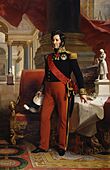 |
Louis Philippe I "the Citizen King" |  |
1830 – 1848 | Distant cousin of Charles X. The French Parliament made him king after Charles X gave up his throne. | Born 1773, died 1850 (aged 76). He was called "King of the French." He was removed from power and gave up his throne for his grandson. |
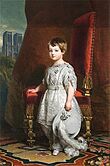 |
Louis Philippe II (claimant) |
1848 (2 days; disputed) | Grandson of Louis-Philippe. | Born 1838, died 1894 (aged 56). The National Assembly refused to recognize him as king. |
The House of Bonaparte: Second French Empire (1852–1870)
The French Second Republic lasted from 1848 to 1852. Then, its president, Charles-Louis-Napoléon Bonaparte, was declared Emperor of the French. He took the name Napoleon III. He was later overthrown during a war. He was the last monarch to rule France.
| Portrait | Name | Arms | Reign | How They Became Emperor | Key Facts |
|---|---|---|---|---|---|
 |
Napoleon III |  |
1852 – 1870 | Nephew of Napoleon I. He was elected President. He then made himself Emperor after a coup. | Born 1808, died 1873 (aged 64). He was captured by the German army. He was removed from power after the Third Republic was declared. |
Who Claims the Throne Now?
Various people today claim to be the rightful monarch of France. They do not accept the current French president. These groups are:
- Legitimist claimants: These are descendants of the Bourbon kings.
- Blancs d'Espagne: These are descendants of Louis XIV. They believe they should be king because they are the oldest male line. However, their ancestor, King Philip V of Spain, gave up his claim to the French throne in a treaty.
- Orléanist claimants: These are descendants of Louis-Philippe. They believe he became king because the French people chose him. They argue that the Bourbons were rejected by the people.
- Bonapartist claimants: These are descendants of Napoleon I and his brothers. They believe the Imperial throne should return to the House of Bonaparte. They say that the people chose the Bonaparte emperors through votes. They also argue that the Bonapartes were only removed from power by foreign enemies, not by a popular revolution.
Timeline of French Monarchs
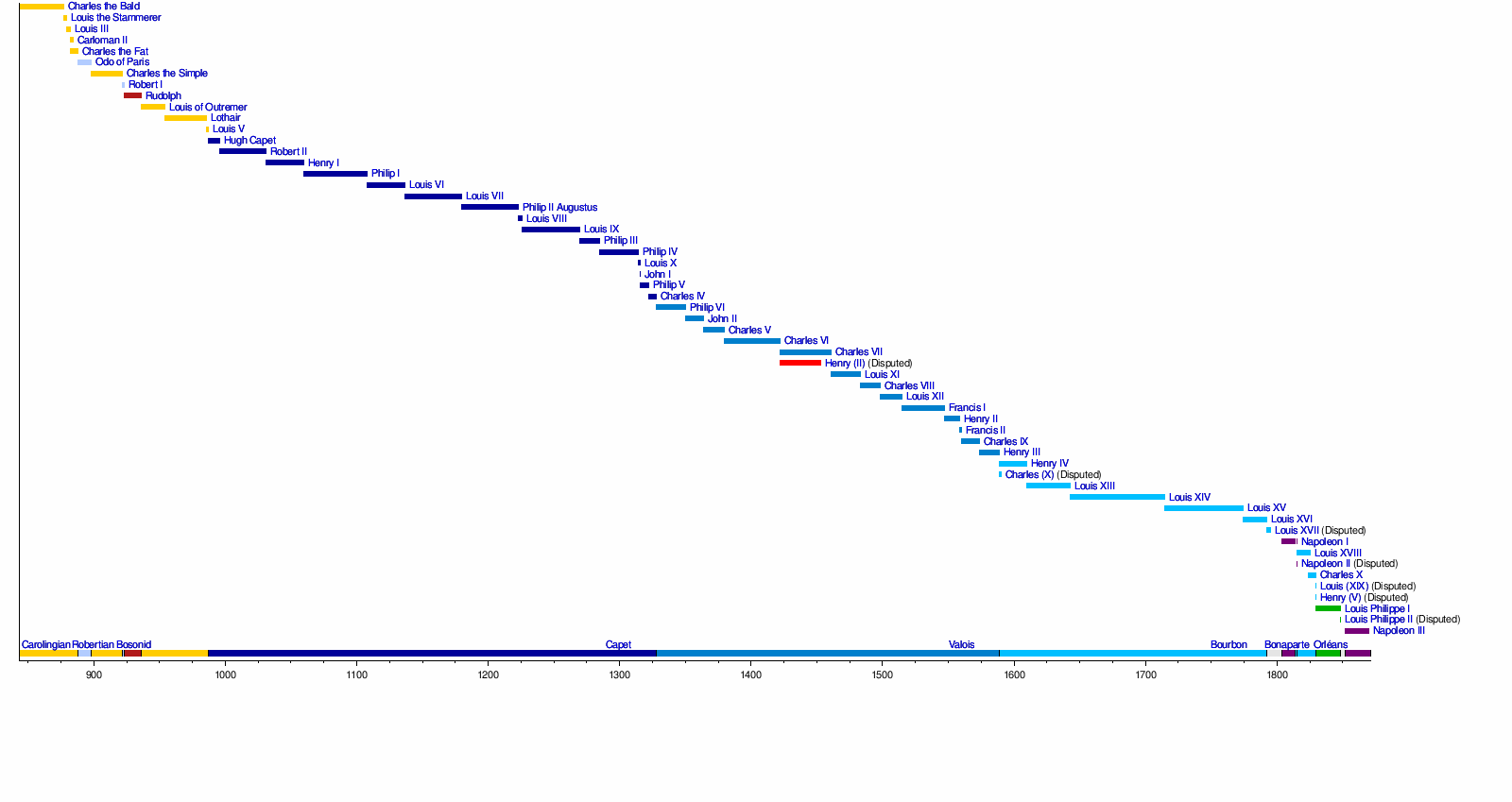
See also
 In Spanish: Anexo:Monarcas de Francia para niños
In Spanish: Anexo:Monarcas de Francia para niños
- Family tree of French monarchs
- Family tree of French monarchs (simplified)
- English claims to the French throne
- List of French royal consorts
- List of heirs to the French throne
- List of presidents of France
- Succession to the French throne











